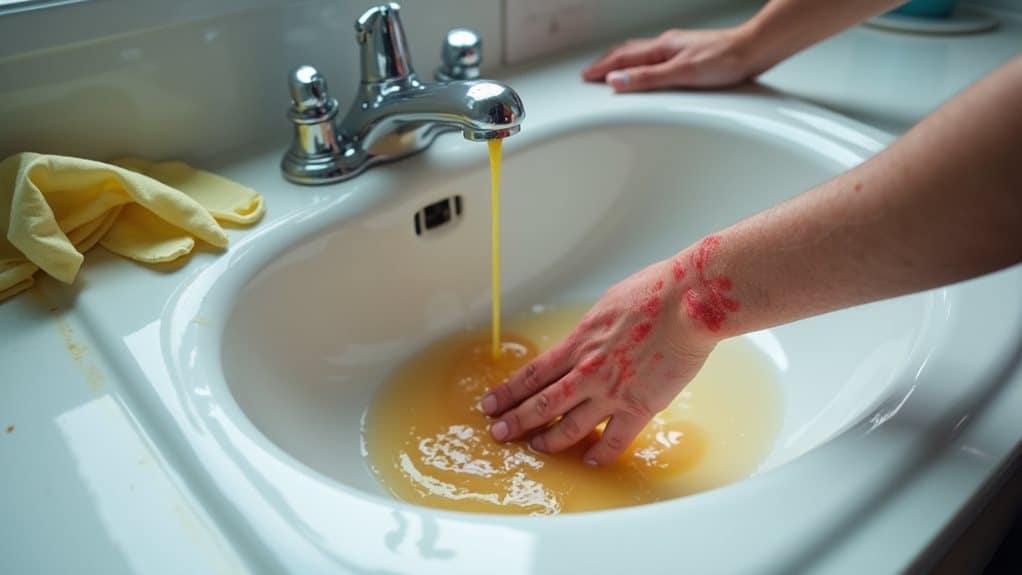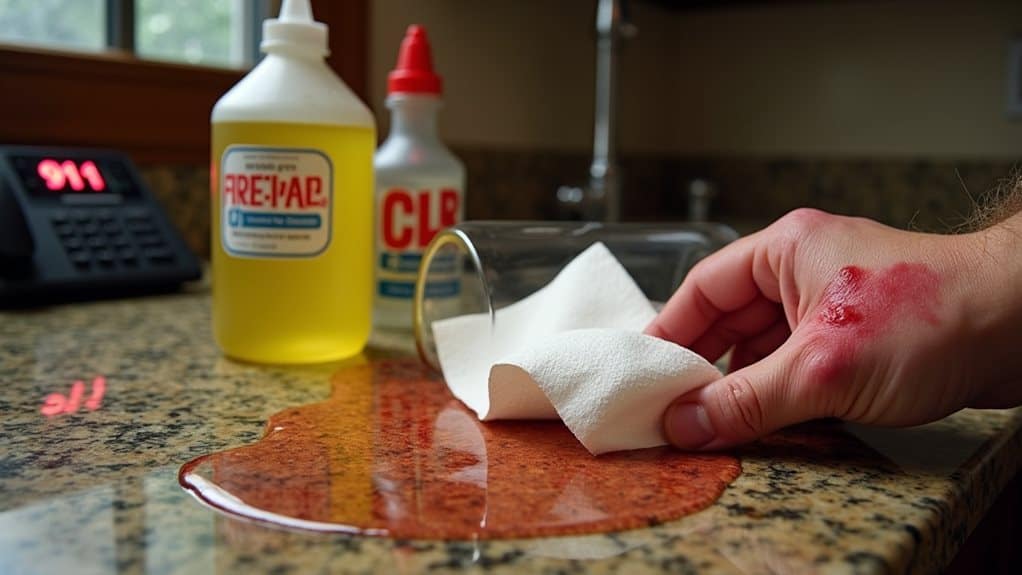CLR can be toxic if you swallow it, inhale its fumes, or get it on your skin or in your eyes. While it has a relatively low toxicity level, it contains acids and chemicals that can cause burns, irritation, and breathing problems. You’ll need protective gear like gloves and eyewear when using it, and proper ventilation is vital. If exposure occurs, rinse with water and seek medical help. Understanding proper handling techniques guarantees your safety when working with this cleaner.
Quick Guide
- CLR has relatively low toxicity (LD50 > 5,000 mg/kg) but can cause serious irritation and burns upon direct contact with skin or eyes.
- Accidental ingestion of CLR can result in oral burns, vomiting, and requires immediate medical attention.
- The product contains acids and chemicals that can irritate airways when inhaled, especially in poorly ventilated spaces.
- While not fatally poisonous to humans, CLR requires proper safety equipment like gloves and eyewear during use.
- Emergency response includes thorough water rinsing for 15 minutes and promptly contacting poison control or medical services.
Understanding CLR’s Chemical Components

CLR’s chemical composition features a complex blend of acids and surfactants that work together to tackle tough mineral deposits.
The main ingredients include lactic acid and gluconic acid, which dissolve mineral buildup, while lauramine oxide acts as a surfactant. The effectiveness of CLR can be attributed to the balance of these cleaning agents, which allows it to safely remove stubborn stains.
You’ll also find propylene glycol derivatives that enhance the solution’s effectiveness and sulfamic acid that amplifies its cleaning power. The formula is specifically designed by Jelmar LLC to ensure effective cleaning while maintaining safety standards.
Health Risks and Toxicity Levels
While CLR isn’t considered highly toxic, it does present several health risks that you’ll need to understand before using it.
You’ll notice eye irritation, including redness and blurred vision, if it contacts your eyes. Skin exposure can cause redness and itching, while accidental ingestion may lead to oral burns and vomiting.
With an LD50 over 5,000 mg/kg, it’s relatively non-toxic but requires careful handling. Additionally, exposure to bacteria growth can pose significant health concerns, particularly if the product is not used in a well-ventilated area.
Immediate Effects of CLR Exposure

If you come into contact with CLR, you’ll notice skin irritation and redness on contact areas.
Eye exposure causes serious irritation with stinging and blurred vision, while accidental ingestion leads to oral burns and vomiting.
Inhalation may trigger breathing difficulties and respiratory tract irritation. Additionally, exposure to certain substances, such as toxic plants, can exacerbate these symptoms, highlighting the importance of maintaining a safe environment.
Protective Measures When Using CLR
To protect yourself when working with CLR, you’ll need essential safety equipment including chemical-resistant gloves, protective eyewear, and impervious clothing that covers your skin.
You should always handle CLR in well-ventilated areas to prevent inhaling fumes, and keep the product stored in tightly sealed containers away from heat sources and food items.
Proper handling involves quick cleanup of spills using absorbent materials, immediate washing of any skin contact areas, and ensuring you have easy access to an eyewash station or clean water source for emergency rinsing. Additionally, ensure that you are aware of the risks of shape change in glassware when using hot liquids to prevent accidents while cleaning.
Personal Protection Equipment Essentials
Safe handling of CLR requires five essential pieces of protective equipment to prevent chemical burns and exposure risks.
You’ll need safety goggles or glasses to protect your eyes, chemical-resistant gloves for your hands, and impervious clothing to shield your skin.
Don’t forget to wear impermeable boots and use a NIOSH-approved respirator when working in areas with poor ventilation.
Safe Handling Best Practices
Beyond wearing proper protective equipment, proper CLR handling procedures play a key role in preventing accidents and injuries.
You’ll need to work in well-ventilated areas and keep containers tightly sealed when not in use.
Don’t mix CLR with water or other substances, and immediately clean up any spills using absorbent materials.
If your clothing becomes contaminated, change and wash it promptly.
Ventilation and Storage Requirements
When working with CLR, proper ventilation and storage procedures serve as your first line of defense against potential hazards.
Like other chemical pollutants, CLR requires strict handling protocols to minimize exposure risks based on environmental safety guidelines.
You’ll need adequate air circulation to prevent breathing harmful vapors, especially in confined spaces.
Store your CLR in its original container, tightly sealed, in a cool, well-ventilated area.
Keep it away from combustible materials and out of children’s reach.
Safe Handling and Storage Guidelines
Proper handling and storage of CLR require specific safety measures to protect both users and the environment.
You’ll need to wear protective gloves and goggles when handling the product, and make certain you’re working in a well-ventilated area.
Store CLR in a cool, dry place away from food items, and keep containers sealed to protect from moisture.
Don’t store it near strong bases or allow it to freeze.
Emergency Response to CLR Contact

If you’ve come into contact with CLR, you’ll need to take immediate action by thoroughly flushing the affected area with cool water for at least 15 minutes while removing any contaminated clothing.
You should seek medical attention right away, especially if the CLR has made contact with your eyes, mouth, or a large area of skin.
Don’t wait to see if symptoms develop – contact emergency services or poison control immediately, and if possible, bring the CLR container with you to help medical professionals provide the most appropriate treatment.
Immediate First Aid Steps
The severity of CLR exposure requires immediate and specific first aid actions to minimize potential harm.
If you’ve been exposed, immediately flush the affected area with cold water. Remove any contaminated clothing and neutralize the chemical with baking soda if possible.
For eye contact, rinse thoroughly for at least 15 minutes and seek medical attention.
If inhaled, move to fresh air quickly.
Contact Medical Help Guidelines
Following immediate first aid measures, seeking professional medical assistance requires quick and organized action.
Call the Poison Help hotline at 1-800-222-1222 immediately.
You’ll need to provide essential details about the exposed person’s age and weight, how they contacted CLR, when the exposure occurred, and what symptoms they’re experiencing.
Have the product container ready for reference.
Long-Term Health Considerations
Research examining long-term health impacts of clarithromycin (CLR) has yielded mixed results across different populations.
While studies don’t show significant long-term risks for most people, you’ll need extra caution if you have cardiovascular disease.
Meta-analyses indicate CLR doesn’t increase overall mortality compared to other treatments, though some studies suggest possible cardiac risks in specific cases.
Always consult your healthcare provider about potential concerns.
Wrapping Up
While CLR isn’t immediately fatal, you’ll need to take its safety risks seriously. Always use protective gear, maintain proper ventilation, and store the cleaner out of children’s reach. If you experience exposure, follow emergency protocols immediately and seek medical attention if symptoms persist. By understanding CLR’s chemical nature and following safety guidelines, you can effectively use this product while protecting your health.

